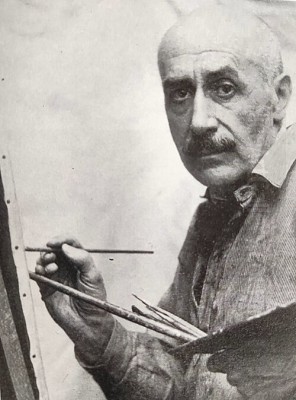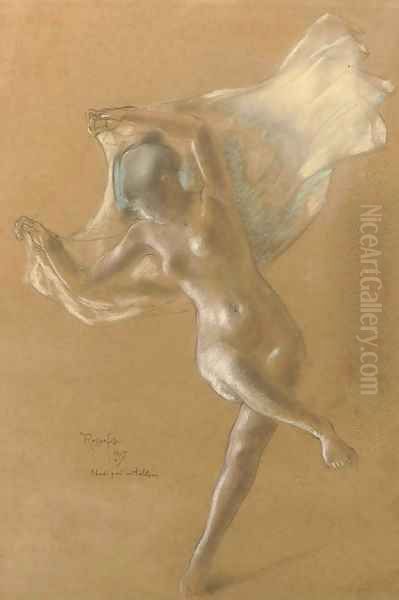
Armand Rassenfosse stands as a significant figure in Belgian art history, a versatile talent known primarily as an illustrator, book artist, painter, and especially as a master etcher. Born in Liège in 1862 and passing away in the same city in 1934, his life spanned a period of rich artistic transformation in Europe. Notably self-taught, Rassenfosse carved a unique path, blending technical ingenuity with a sensitive portrayal of the human form, leaving behind a legacy that continues to be appreciated for its skill and emotional depth.
Early Life and Artistic Awakening
Born into a family that managed a successful business dealing in decorations and home furnishings in Liège, Armand Rassenfosse's early life seemed destined for commerce rather than art. However, a burgeoning interest in the visual arts gradually steered him away from the family trade. Eschewing formal academic training, he embarked on a journey of self-discovery in the artistic realm. His initial explorations involved collaborations with local figures like art teacher Dethier Adrian, experimenting with various techniques and honing his innate skills, particularly in drawing and printmaking. This period laid the groundwork for his future innovations and distinctive style.
The Crucial Collaboration with Félicien Rops
A pivotal moment in Rassenfosse's career occurred around the age of 25 when he met the established and somewhat notorious Belgian artist Félicien Rops. This encounter blossomed into a deep friendship and a fruitful artistic partnership. Rops, already a master of etching and known for his Symbolist and often provocative works, became a mentor figure to the younger Rassenfosse. Together, they delved into the technical aspects of printmaking, leading to a significant innovation: a new soft-ground etching technique. This method, often playfully dubbed "Ropsenfosse," allowed for greater subtlety and tonal variation, significantly impacting the possibilities within the medium and becoming a hallmark of their collaborative spirit. Rops's guidance and their shared experiments were instrumental in shaping Rassenfosse's technical mastery.
Technical Prowess and Innovation

Rassenfosse was not merely an artist adapting existing methods; he was an active innovator driven by a desire to refine and expand the printmaker's toolkit. Beyond the co-development of the "Ropsenfosse" technique, he tackled practical challenges inherent in the printing process. He is credited with inventing a novel technique to address the persistent problem of mirror-image reversal in printmaking, simplifying the process for artists wishing to achieve a specific orientation in their final prints. Furthermore, during the 1890s, he dedicated himself to formulating special etching ink recipes, seeking specific qualities of viscosity, permanence, and color intensity. These technical contributions underscore his deep engagement with the craft of printmaking, positioning him as both an artist and an inventor within his field.
Masterwork: Illustrating Baudelaire's Les Fleurs du Mal
Perhaps the most celebrated achievement in Armand Rassenfosse's oeuvre is his series of illustrations for Charles Baudelaire's seminal collection of poetry, Les Fleurs du Mal (The Flowers of Evil). This project, undertaken with profound sensitivity to Baudelaire's complex and often dark themes, resulted in a remarkable suite of etchings, many realized in subtle color variations. Rassenfosse's interpretations focused compellingly on the intimate lives of women, capturing moments of contemplation, vulnerability, and sensuality that resonated with the poems' explorations of modern life, beauty, and decay. These illustrations are considered masterpieces of Symbolist book art, showcasing his technical finesse in etching and his ability to translate literary mood into visual form. His work here finds echoes in the Symbolist explorations of contemporaries like Gustave Moreau or Odilon Redon, who also delved into themes of interiority and the enigmatic.
Evolving Styles and Artistic Sensibilities
Throughout his career, Rassenfosse demonstrated a remarkable stylistic versatility. His early work, particularly in etching, is characterized by technical precision and a certain refinement inherited from his collaboration with Rops. However, his artistic language was not static. Especially after the traumatic period of the First World War, his approach, particularly in painting, shifted towards a more expressive and painterly style. While perhaps not strictly adhering to Neo-Impressionism like his Belgian contemporary Théo van Rysselberghe, his later works show a loosening of line and a greater emphasis on capturing mood and light through color and brushwork, leaning towards a personal form of expressionism. This evolution reflects his continuous exploration of different artistic means to convey his vision.
The Female Form: A Central Theme

Central to Rassenfosse's art, across different media and stylistic phases, is his fascination with the female form. He depicted women in various contexts, from intimate domestic scenes and moments of private toilette to figures embodying societal roles or allegorical concepts. His portrayals are often characterized by an elegance and grace, yet they frequently convey a sense of introspection, solitude, or vulnerability. Unlike the more idealized nudes of artists like Auguste Renoir, or the often detached, observational studies of Edgar Degas, Rassenfosse imbued his female figures with a palpable psychological presence. He explored their inner lives as much as their outward appearance, making his depictions both aesthetically pleasing and emotionally resonant.
Japonisme's Touch
Like many European artists of the late 19th and early 20th centuries, Rassenfosse felt the influence of Japanese art, a trend known as Japonisme. The aesthetics of Japanese Ukiyo-e woodblock prints, with their flattened perspectives, bold outlines, and decorative compositions, subtly informed his work. This influence is discernible in certain compositional choices, the elegance of line in some of his figures, and occasionally in thematic elements, such as the reported inclusion of judo practitioners in a work associated with Art Nouveau. This engagement with non-Western aesthetics placed him alongside contemporaries like James McNeill Whistler, Vincent van Gogh, and Henri de Toulouse-Lautrec, who similarly found inspiration in the art of Japan, integrating its principles into their own distinct modern styles.
Beyond Illustration: Painting and Drawing
While renowned for his graphic work, Rassenfosse was also a dedicated painter and draftsman. His oil paintings often continued his exploration of the female nude and genre scenes, rendered with increasing expressiveness in his later years. These works allowed him to explore color and texture more fully than etching typically permitted. His drawings, such as the noted Seated Female Nude, reveal his foundational skill in capturing form and anatomy with sensitivity and confidence. Painting, particularly after World War I, became a medium through which he sought to express themes of beauty, love, and music, perhaps as a counterpoint to the preceding years of conflict.
Commercial Ventures and Collaborations
Rassenfosse also applied his artistic talents to the burgeoning field of commercial art, particularly poster design. He collaborated with figures like Jules Chéret, a pioneer of the modern poster in Paris, absorbing aspects of the vibrant, eye-catching style required for advertising. Many of his own posters were printed by the Liège-based printer Auguste Bénard, with whom he established a working relationship from at least 1896 onwards. Notable examples of their collaboration include posters such as L'Art indépendant (1896), Grande Brasserie Van Velsen Fres. Bornhem (1896), Deuxième Exposition Cycles & Automobiles au National Place St Lambert (1897), Tournoi de Lutte de Liège à Fontaine (1899), and Le Fine Art and General Insurance Cie (1900). These works showcase his ability to adapt his style for public communication, often employing rich colors and a distinctively elegant, sometimes retro, aesthetic.
Artistic Circle and Context
Rassenfosse operated within a dynamic Belgian and European art scene. His primary collaborator was Félicien Rops, but his network also included figures introduced by his friend and employer Auguste Donnay, such as the architect and designer Gustave Serrurier-Bovy and the artists known as the Berchmans brothers. His work can be contextualized alongside other prominent Belgian artists of the era, such as the highly individualistic painter and printmaker James Ensor, known for his masks and satirical works, and the leading Symbolist painter Fernand Khnopff, whose enigmatic compositions explored themes of silence and introspection. On a broader European scale, Rassenfosse's interest in printmaking and psychological depth connects him to figures like the Norwegian artist Edvard Munch, whose prints powerfully conveyed emotional turmoil.
War's Shadow and Later Life
The First World War cast a long shadow over Rassenfosse's life and art. The involvement of his son in the conflict deeply affected him. In the post-war years, there was a noticeable shift in his focus, moving more decisively towards painting. His later works often sought refuge in themes of beauty, tenderness, and the consolations of art and music. The depiction of solitary or seemingly vulnerable women continued, perhaps imbued with a heightened sense of pathos or introspection following the collective trauma of the war. He found solace and purpose in the act of painting itself, using it as a means to affirm life and beauty in the face of hardship.
Recognition and Honors
Throughout his career, Armand Rassenfosse received recognition for his artistic contributions. He was honored with the title of Chevalier de l'Ordre Léopold (Knight of the Order of Leopold), a significant Belgian distinction. His work was exhibited not only within Belgium but also in France, attesting to his reputation beyond national borders. He played a role in the local art infrastructure, serving as a member of the art committee for the Liège International Exposition. His dedication to both artistic creation and technical advancement earned him respect among his peers and patrons.
Legacy and Remembrance
Armand Rassenfosse passed away in his native Liège on January 28, 1934. He left behind a substantial body of work encompassing etchings, illustrations, paintings, and drawings. His legacy is multifaceted: he is remembered as a technical innovator in etching, particularly through the "Ropsenfosse" technique; as the sensitive and iconic illustrator of Baudelaire's Les Fleurs du Mal; and as a distinctive voice within Belgian Symbolism and Art Nouveau. His works are preserved in institutional collections, including those of Belgian universities, and continue to be studied and exhibited, ensuring that his contributions to art history, particularly in the realm of printmaking and the intimate portrayal of the human condition, are not forgotten.
Conclusion
Armand Rassenfosse remains a compelling figure in late 19th and early 20th-century European art. As a self-taught artist who achieved mastery in the demanding medium of etching, an innovator who pushed the technical boundaries of printmaking, and a sensitive chronicler of intimacy and the female form, his work offers a unique blend of technical skill and emotional depth. From his groundbreaking collaboration with Félicien Rops to his iconic illustrations for Baudelaire and his later, more expressive paintings, Rassenfosse navigated the complex artistic currents of his time, creating a legacy that continues to resonate with its elegance, innovation, and quiet intensity.